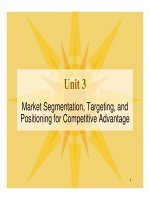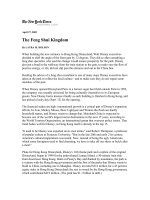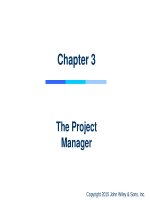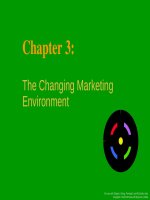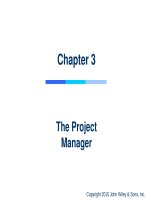3 THE MARKETING ENVIRONMENT
Bạn đang xem bản rút gọn của tài liệu. Xem và tải ngay bản đầy đủ của tài liệu tại đây (3.36 MB, 24 trang )
3. THE MARKETING ENVIRONMENT
Marketing Environment —
Actors and forces outside marketing that
affect marketing management ability to
develop and maintain successful transactions
with target customers.
COLLEGE OF BUSINESS ADMINISTRATION
CHUNG-ANG UNIVERSITY
PROF HYUNSUK SUH
2
The objectives of the current chapter are described.
Objectives
Understand the marketing environment that affect the company’s ability
to serve its customers
Understand the meaning of microenvironment and macroenvironment
Understand tools to analyze marketing situations
0. Objectives
3
The objectives of the current chapter are described.
Chapter Opening Example
0. Objectives
Example
Xerox introduced the first plain-paper copier almost 50 years ago. For years, the company that invented
photocopying dominated the field. In 1998, Xerox’s profits were growing at 20 percent a year.
Then everything went wrong. In only 18 months, Xerox lost $38 billion in market value. The company
was on the brink of bankruptcy.
The world had quickly gone digital and Xerox had not kept up. While Xerox was busy perfecting copy
machines, customers were no longer relied on the company’s flagship products – stand alone copiers.
They were looking for more sophisticated document management solutions. They wanted systems that
would let them scan documents in Frankfurt weave them into colorful showpieces in San Francisco.
Since those dark days, Xerox has rethought, redefined and reinvented itself. The new Xerox mission is
to “help companies and people be smarter about their documents.” Xerox CEO Anne Mulcahy sums
things up this way: “We have transformed Xerox into a business that connects closely with customers
in a content rich digital marketplace.”
The message is clear. Even the most dominant companies can be vulnerable to changing marketing
environments.
4
STRATEGIC PLANNING PROCEDURE
Mission
Objectives
& Goals
Alternative
Strategies/Sols
Internal
Competency
External
Environment
Selection of
Strategy
Execution of
Strategy
Result
The procedure of establishing a company strategy is illustrated in below diagram.
Establishing Company Strategy
Evaluation
&
Feedback
Designing Business
Portfolio
Analysis on the Marketing
Environment
1. Strategic Process
5
TOOLS & FRAMEWORKS
TOOLS & FRAMEWORKS
FAW
5 Forces
Business System &
Value Chain Analysis
7S
3 C
SWOT
ANALYSIS ON THE
EXTERNAL ENVIRONMENT
ANALYSIS ON THE
INTERNAL COMPETENCY
ANALYSIS ON THE
COMPETITIVENESS
Tools and Frameworks for the Analysis
The tools for the analysis of strategic planning should selectively be employed according to
the different purposes intended on the target occasions.
1. Strategic Process
Strategy
( 전략 )
Structure ( 조직구조 )
System ( 운영제도 )
Staff ( 인재 )
Skill ( 조직능
력 )
Style ( 기업풍토 )
Threat of
Substitute
Products
Threat of
New
Entrants
Threat of New
Entrants
Rivalry Among
Competing Firms in
Industry
Bargaining
Power of
Buyers
Bargaining
Power of
Suppliers
Shared Value ( 기업이념 , 공유가치 )
6
7S Check Points
The following is an example of the 7S analysis being actually employed in one of the
business consulting projects.
1. Strategic Process
7S Analysis
What is shows
Pivotal Job Design
How behavior patterns of front-line people need
to change in order to build new institutional skills
Career Path Analysis
Expected career path for key managers
Managerial Candidate Evaluation
Helps match individual managers strengths with
position requirements
Promotion Speed by Function
What functions have or have not been enhanced
by promotion patterns
Career Blochage Analysis
Where and how promotion is blocked or career
progression options are limited
Managers' Background
What backgrounds dominate among managers
or employees at a certain level
Cross-Functional Experience
Whether senior management has a broad or
functional perspective on issues
Turnover Analysis
The extent and organizational location of
employee turnover
Executive Readiness Assessment
Readiness of CEO(and other key executives) to
lead major change
Staff Role and Evolution
The roles staff play and the change in those roles
over time
Organizional Skills Analysis
What the organization is good(or poor) at, the new
skills required to execute a winning strategy, and
the organizational changes necessary
Skills Self-Assessment
What the managers believe are their
organization's strengths and weaknesses
Skills Gap Analysis
If an organization has the necessary skills to
maintain competitive advantage
Competitive Skills Assessment
A comparison of our performance on skills with
competitor's skills performance
Dimensions of Challenge
Company's relative ability to decide the right thing
to do and then implement that chosen direction
Content Analysis
Hard data on the way top management really
spends its time and attention
Actual Time Allocation
Difference between what a manager supposedly
does and what he or she really does to support
out strategy
Shared Values Identification
Makes employees decide what is of crucial
importance to them
Perception Difference Analysis
Whether people at different levels of the
organization see the company the same way
Skill
Style
Shared Value
Staff
7S Analysis
What is shows
Strategic Era Analysis
The organizational characteristics of the
past eras
Changes Strategy Matrix
Magnitude of required change and
pressures for/against it
Decision Grid
How and where decisions are made as well
as centralization/decentralization concerns
Responsibility Dispersion
How Many people are involved in making key
decision(is anybody responsible?)
Expenditure Authority
The extent to which managers have the
proper level of authority over expenditures
Organization Chart Analysis
Structural barriers to organizational
effectiveness
"Real" Organization Chart
The effects of actual reporting relationships
in an organization-as opposed to the official
ones
Overhead Distribution Analysis
If the numer and location of overhead
personnel supports the company's strategy
Systems Analysis
If systems provide a source of competitive
advantage
Strategic Impact of Systems
If systems are appropriately calibrated to a
company's strategy and management is
giving appropriate attention to key systems
Decision Flows
Decision-making patterns which support or
diminish an organization's efficiency
Systems Evolution Flow Chart
If systems have evolved to keep pace with
changes in the organization or the
competitive environment
Systems/Process Flows
If Information or a product is efficiently
transmitted across the organization
Systems Redesign
What current systems focus on and how they
might be more effectively designed
Compensation Comparision
Competitive and behavioral impact of
compensation package
Reward Systems Analysis
If the reward systems are still meaningful and
in support of the company's strategy
Strategy
Structure
System
Example
7
Forces at Work
The tools for the analysis of strategic planning should selectively be employed according to
the different purposes intended on the target occasions.
1. Strategic Process
8
What is “Marketing Environment”?
Marketing Environment
The actors and forces that affect a firm’s ability to build and maintain
successful relationships with target customers.
Aspects of the marketing environment:
- Micro environment : Includes the actors close to company
- Macro environment: Involves larger social forces
Kotler and Armstrong, 2011, 2013
2. Marketing Environment Definition
9
The Microenvironment of the Company
The major actors in marketer’s microenvironment to create customer value and
satisfaction are illustrated below.
company
company
MACRO
MICRO
S
u
p
p
l
i
e
r
S
u
p
p
l
i
e
r
C
u
s
t
o
m
e
r
C
u
s
t
o
m
e
r
C
o
m
p
e
t
i
t
o
r
C
o
m
p
e
t
i
t
o
r
I
n
t
e
r
m
e
d
i
a
r
y
I
n
t
e
r
m
e
d
i
a
r
y
Public
Public
P
o
l
i
t
i
c
a
l
P
o
l
i
t
i
c
a
l
T
e
c
h
n
o
l
o
g
i
c
a
l
T
e
c
h
n
o
l
o
g
i
c
a
l
E
c
o
n
o
m
i
c
E
c
o
n
o
m
i
c
N
a
t
u
r
a
l
N
a
t
u
r
a
l
Demographic
Demographic
MICROENVIRONMENT
Actors close to the company that affect its ability to serve
its customers
1. Suppliers
Provide resources to produce the company
goods and services (e.g. resource, part, and facility)
2. Intermediaries
Help company to promote, sell, and distribute its
goods to final buyers (e.g. reseller, physical distribution
firm, marketing service agency, financial service)
3. Customers
Consumer/ Business/ Reseller/ Government/
International markets that include all of above
4. Competitors
5. Public
Any group with actual & potential interest/impact
on organization’s ability to achieve its objectives
Cultural
Cultural
3. Microenvironment
10
자 사
(Company)
경쟁사
(Competitor)
고 객
(Customer)
3C
To understand and deal with the competitive environment today, 3C analysis works on
the core factors of following levels; the customer, competitor, and company.
3C Analysis
1. Who are they?
2. Characteristics and Behaviors?
3. Size of target market?
1. Who are our competitors?
2. Pros and Cons?
3. Best practices?
1.Major products and services?
2.Organization?
3.Pros and Cons?
4. 3C and SWOT
11
The list of things to consider for your competitors are suggested below.
Competitor Analysis: Start from
Competitor Analysis has several important roles in strategic planning:
• To help management understand their competitive advantages/disadvantages relative
to competitors
• To generate understanding of competitors’ past, present (and most importantly)
future strategies
• To develop strategies to achieve competitive advantage in the future
Questions to Ask:
• Who are our competitors?
• What threats do they post?
• What is the profile of our competitors?
• What are the objectives of our competitors?
• What strategies are our competitors pursuing and how successful are these strategies?
• What are the strengths and weaknesses of our competitors?
• How are our competitors likely to respond to any changes to the way we do business?
Suggestion
4. 3C and SWOT
12
KOREAN
POSTAL
SERVICE
CUSTOMER
COMPETITOR
•
대국민 공공서비스 제공이라는 목표에
우정서비스 수익성 제고라는 목표 추가
•
우편집배권역 광역화
•
Hub & Spoke 운송망 체제확립
•
민간택배수준의 서비스 제공 추진
•
통합우편물류 정보시스템 구축 추진
•
일반통상서비스의 주고객이 개인에서
기업으로 변화
•
기존 소포서비스에 대한 우편고객의
만족도가 감소
•
고객지향적인 서비스를 제공하는 택
배서비스 선호
•
기존 국내 택배업체들의 성장 및 신규진
출 택배업체의 증가
•
외국 우편물류 사업자들의 세계와 전략
을 통한 한국진출 및 적극적인 사업추진
•
기업발송 우편물의 처리 효율화
•
가치부가적인 소포서비스 마련
•
서비스 개선 및 물류망 정비에 따
른 업무조정 및 재배치
•
택배업체와의 경쟁력 강화 및 협
력전략수립
ISSUES
3C: Korean Postal Service Project
The following example is extracted from one of the consulting project outputs. Are
there any connections between the issues and analyses? See for yourself.
4. 3C and SWOT
Example
13
- What areas of business need most
improvement?
- As environmental forces/changes
affect and influence the marketplace,
what new threats are emerging?
- As environmental forces/changes
affect and influence marketplace,
what opportunities are emerging?
- What are the core competencies of
our company? (what do we do well?)
- What is the company’s reputation in
the market place?
O
Strength Weakness
Threat
Opportunity
*SWOT 분석은 외부환경의 기회요인과 위협요인을 파악하고 기업 내부의 강점 및 약점을 분석한 후 상호 교차적인 전략적
대안을 도출하는 방법임
The questions you need to deal with SWOT analyses are addressed below.
SWOT Analysis
4. 3C and SWOT
14
The SWOT analysis concerns internal strengths and weaknesses and finds out what
external opportunities and threats are, to draw overall strategic view of the company.
Opportunities Strengths
Threats Weaknesses
전략적 대안과 시사점의 도출
IMPLICATIONS
External Analysis Internal Analysis
SWOT Analysis
4. 3C and SWOT
15
Strengths
Weaknesses
Opportunities
Threats
내부능력
외부환경
SO WO
ST WT
분석을 통한 몇 가지 시사점
도출 !
.
.
.
.
* SWOT : Strengths, Weaknesses, Opportunities, Threats
자사의 강점 파악
외부환경의
기회요인 파악
자사의 약점 파악
외부환경의
위협요인 파악
강점을 이용한
외부환경기회의
활용 전략방안 .
약점을 보완한
외부환경위협의
대응 전략방안 .
강점을 이용한
외부환경위협의
대응 전략방안 .
약점을 보완한
외부환경기회의
활용 전략방안 .
Through SWOT analysis, a company can utilize full potentials, minimize weaknesses,
prepare solutions for threats, and seize good opportunities in the future.
SWOT
Application
4. 3C and SWOT
16
The Macroenvironment of the Company
company
company
MACRO
MICRO
S
u
p
p
l
i
e
r
S
u
p
p
l
i
e
r
C
u
s
t
o
m
e
r
C
u
s
t
o
m
e
r
C
o
m
p
e
t
i
t
o
r
C
o
m
p
e
t
i
t
o
r
I
n
t
e
r
m
e
d
i
a
r
y
I
n
t
e
r
m
e
d
i
a
r
y
Public
Public
P
o
l
i
t
i
c
a
l
P
o
l
i
t
i
c
a
l
T
e
c
h
n
o
l
o
g
i
c
a
l
T
e
c
h
n
o
l
o
g
i
c
a
l
E
c
o
n
o
m
i
c
E
c
o
n
o
m
i
c
N
a
t
u
r
a
l
N
a
t
u
r
a
l
Demographic
Demographic
MACROENVIRONMENT
1. Demographic
Study of human population in terms of size, density,
location, age, gender, race, occupation, etc.,
2. Cultural
Institutions and forces affect society’s basic values,
perceptions, preferences, and behaviors
3. Natural
Natural resources needed by marketing activities
4. Political
Laws and government agencies that influences
organization
and individuals
5. Technological
New technologies create market opportunities and
new products
6. Economical
Factors affecting consumer behavior and buying power
Cultural
Cultural
In a larger sense, the macroenvironment shapes opportunities, and poses threats to
the company. Six(6) major forces are illustrated below.
5. Macroenvironment
17
The demographic environment is the most basic factor that determines size of the
market.
Statistics for the World Population
Imagine the world is a large village, and the total number of people is 1,000, our village
would . . .
1. 520 females and 480 males, 330 children, 60 people over 65, 10 college graduates,
and 335 illiterate
2. 52 North Americans, 55 Russians, 84 Latin Americans, 95 Europeans, 124 Africans, and
584 Asians
3. 329 Christians, 178 Moslems, 32 Hindus, 60 Buddhists, 3 Jews, 161 non-religious,
and 45 atheists
4. 1/3 have access to clean, safe drinking water, half of children would be immunized
5. 200 controls 75% of wealth, 70 own cars, 1 own computers that even may not be connected
Demographic Environment of Korea
1. Decreasing Birth Rate (Summated Birthrate-between the child bearing period b/w 15-49yrs)
(1980-2.92 명 , 1990-1.60 명 , 2000-1.51 명 , 2005-1.24 명 , 2010-1.21 명 )- Markets?
2. Increasing number of people over the age of “65”
(1980-1,446 명 , 2000-3,372,000 명 , 2005-4,370,000, 2010-5,420,000 (24.3% increase))
3. Increasing divorce rate (2005- 1,140,000 명 , 2010-1,610,000 명 (41.2% increase))
4. Increasing number of foreign workers (2005-237,517 명 , 2010-589,532 (148.2% increase))
5. Macroenvironment
18
It takes only 26 years for us to reach from aging society(7~14% of pop. is composed of
people with ages 65 or older) to aged society(20% or more of pop. Is composed of
people with ages 65 or older).
도달연도 소요연수
7% 14% 20% 7%14% 14%20%
한 국
2000 2019 2026 19 7
일 본
1970 1994 2006 24 12
프 랑 스
1864 1979 2020 115 41
독 일
1932 1972 2012 40 40
영 국
1929 1976 2021 47 45
이탈리아
1927 1988 2007 61 19
미 국
1942 2013 2028 71 15
고령화 사회 초 고령사회로의 도달이
우리나라 26 년 , 일본 36 년 , 미국 86
년 , 그리고 프랑스 156 년으로 추정함
Years take to reach aging and aged society
Example
5. Macroenvironment
19
Changing Age Structure
Changing age structure of the population can result into three or more different
generations.
Baby Boomers
Generation X
Generation Y
5. Macroenvironment
Born between 1946~1964
75 million consumers
72% are planning to work after
retirement
From ‘youth quake” to
‘backache” generation
Believe old age begins at 80
Feel much younger due to
their mental attitude
Born between 1965~1978
40 million consumers
First “latchkey” children-
products of dual career
households
Now in their 30s and 40s
planning to send their kids off
to college
Home ownership is important
goal for them
Born between 1979~1994
75 million strong: almost as
large a group as their baby
boomer parents
New products and services
(e.g. Tommy Hilfiger, DKNY,
Gap, Toys “R” us, Talbots,
Eddie Bauer, etc.)
Computer, Internet and
digitally savvy
Challenging target for
marketers
20
Let’s take a look at some of the business fields that can target for the Silver Market.
5. Macroenvironment
Issues of Disability
What is Disability ?
Example
21
Cultural environment is explained as the institutions and other forces that affect
society’s basic values, perceptions, preferences, behaviors, and even
communications.
5. Macroenvironment
- Verbal Cues
- Nonverbal Cues or Body Language
Language and Communications
CULTURE WATCH: Using English as a Marketing Tool in Japan
In Japan, consumer packaged goods have English, French, or German labels to suggest a
stylish, Western look. A Westerner may wonder what the copywriters wish to achieve.
English on the label of City Original Coffee proclaims "Ease Your Bosoms. This coffee has
carefully selected high quality beans and roasted by our all the experience." The intended
message: Drinking the coffee provides a relaxing break and "takes a load off your chest."
One expert believes these messages highlight differences between Japanese and other
languages. Many Western languages lack exact equivalents for the rich variety of Japanese
words that convey feelings. This presents difficulties for copywriters trying to render
feelings in a language other than Japanese.
Q: Why are Japanese retailers unconcerned that the messages are syntactically suspect ?
Culture Watch: Using English as a Marketing Tool in Japan
22
5. Macroenvironment
HIGH CONTEXT
- Nonverbal messages are full of important and intended meanings
- When words are spoken, “reading between the lines” is important emphasis
on background, basic values
-The meaning of individual behavior and speech changes depending on the
situation or context
- Less emphasis on legal paper work
- Focus on personal reputation
- Latin American countries, Japan, and industrializing Asian countries
LOW CONTEXT
- Messages are explicit and specific
- Words carry all information (intentions are expressed verbally)
- Reliance on legal paperwork
- Focus on non-personal documentation of credibility
- Low context cultures can be found in culturally diverse countries such as
Switzerland, US, and Germany
The important distinction between cultures suggested by Hall is that between HIGH
and LOW context cultures which are described below.
High and Low Context Cultures
5. Macroenvironment
23
The high and low context cultures across different countries are illustrated below.
High and Low Context Cultures
H/L Communication Style
A US business man picked up a German
client from his hotel near LAX and asked
what kind of food he wanted for dinner. He
said, “something local.” Now in LA, the
local food is Mexican food. We went to a
great Mexican restaurant in Santa Monica
and had it all. When we were done I asked
him how he like the food. He responded
rather blandly, “It wasn’t very good”.
Germans being low-context oriented, they
deliver information without any social
padding. If it was Americans in the same
situation, the answer would more likely be
“It was pretty good but a bit too spicy.” A
Japanese would answer “It was very good.
Thanks.” But he would never order Mexican
food again.
Example
24
Other macro environment also affect on the company’s marketing activities.
NATURAL ENVIRONMENT
1. Shortage of raw materials (e.g. water)
2. Pollution
3. Government Intervention
e.g. Chiclets gum (12) In India? (2)
TECHNOLOGICAL ENVIRONMENT
Companies should keep up with technological changes so that they do not miss new
products and market opportunities.
Other Environments
5. Macroenvironment
Issues regarding Technology?



